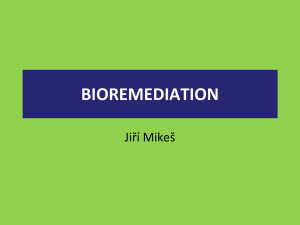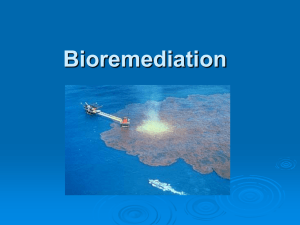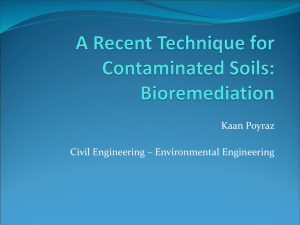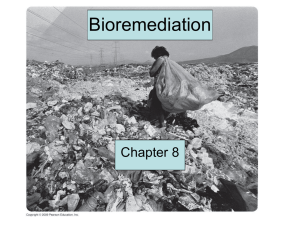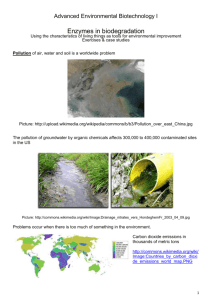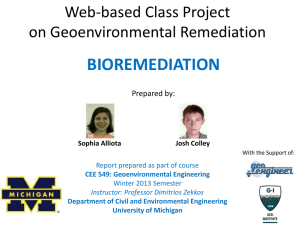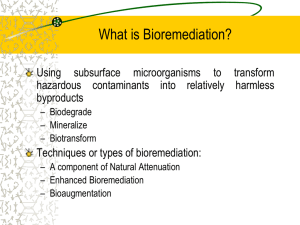Biorem & Nature - Falconer Central School
advertisement
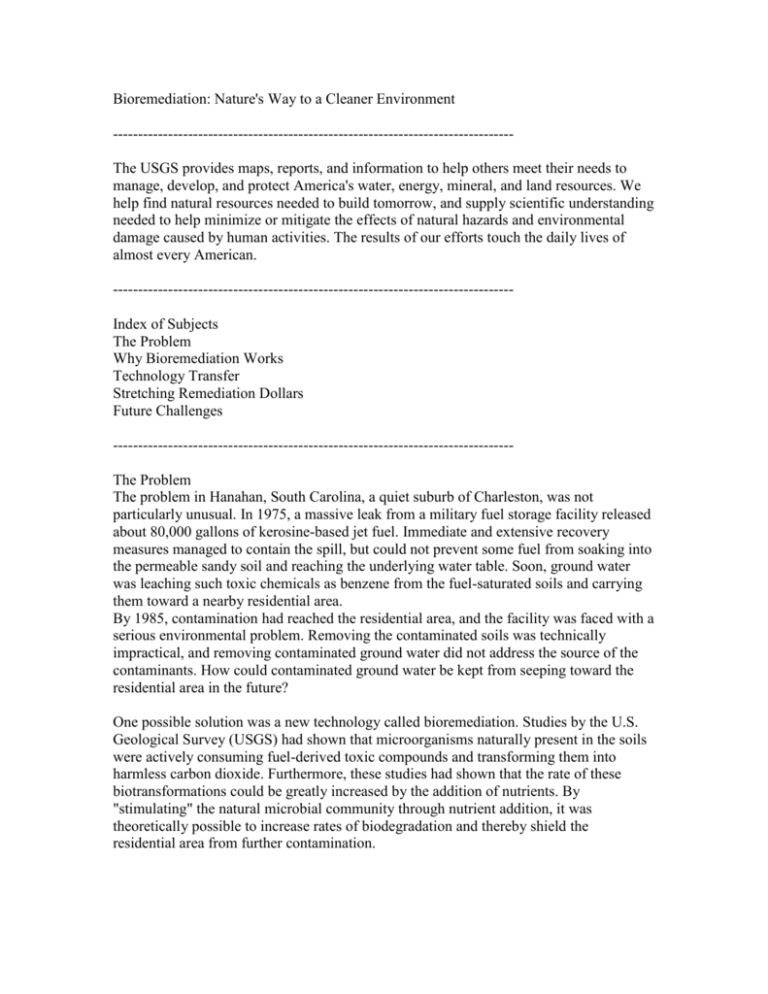
Bioremediation: Nature's Way to a Cleaner Environment -------------------------------------------------------------------------------The USGS provides maps, reports, and information to help others meet their needs to manage, develop, and protect America's water, energy, mineral, and land resources. We help find natural resources needed to build tomorrow, and supply scientific understanding needed to help minimize or mitigate the effects of natural hazards and environmental damage caused by human activities. The results of our efforts touch the daily lives of almost every American. -------------------------------------------------------------------------------Index of Subjects The Problem Why Bioremediation Works Technology Transfer Stretching Remediation Dollars Future Challenges -------------------------------------------------------------------------------The Problem The problem in Hanahan, South Carolina, a quiet suburb of Charleston, was not particularly unusual. In 1975, a massive leak from a military fuel storage facility released about 80,000 gallons of kerosine-based jet fuel. Immediate and extensive recovery measures managed to contain the spill, but could not prevent some fuel from soaking into the permeable sandy soil and reaching the underlying water table. Soon, ground water was leaching such toxic chemicals as benzene from the fuel-saturated soils and carrying them toward a nearby residential area. By 1985, contamination had reached the residential area, and the facility was faced with a serious environmental problem. Removing the contaminated soils was technically impractical, and removing contaminated ground water did not address the source of the contaminants. How could contaminated ground water be kept from seeping toward the residential area in the future? One possible solution was a new technology called bioremediation. Studies by the U.S. Geological Survey (USGS) had shown that microorganisms naturally present in the soils were actively consuming fuel-derived toxic compounds and transforming them into harmless carbon dioxide. Furthermore, these studies had shown that the rate of these biotransformations could be greatly increased by the addition of nutrients. By "stimulating" the natural microbial community through nutrient addition, it was theoretically possible to increase rates of biodegradation and thereby shield the residential area from further contamination. In 1992, this theory was put into practice by USGS scientists. Nutrients were delivered to contaminated soils through infiltration galleries, contaminated ground water was removed by a series of extraction wells, and the arduous task of monitoring contamination levels began. By the end of 1993, contamination in the residential area had been reduced by 75 percent. Nearer to the infiltration galleries (the source of the nutrients), the results were even better. Ground water that once had contained more than 5,000 parts per billion toluene now contained no detectable contamination. Bioremediation had worked! Why Bioremediation Works The success of the Hanahan Bioremediation Project was no accident. It was the result of many years of intensive effort by many USGS scientists. In the early 1980's, little was known about how toxic wastes interact with the hydrosphere. This lack of knowledge was crippling efforts to remediate environmental contamination under the new Superfund legislation---the Comprehensive Environmental Response, Compensation, and Liability Act. Faced with this problem, Congress directed the USGS to conduct a program to provide this critically needed information. By means of this program, known as the Toxic Substances Hydrology Program, the most important categories of wastes were systematically investigated at sites throughout the United States. One of the principal findings of this program was that microorganisms in shallow aquifers affect the fate and transport of virtually all kinds of toxic substances. For example: Crude oil spill, Bemidji, Minnesota ---In 1979, a pipeline carrying crude oil burst and contaminated the underlying aquifer. USGS scientists studying the site found that toxic chemicals leaching from the crude oil were rapidly degraded by natural microbial populations. Significantly, it was shown that the plume of contaminated ground water stopped enlarging after a few years as rates of microbial degradation came into balance with rates of contaminant leaching. This was the first and best-documented example of intrinsic bioremediation in which naturally occurring microbial processes remediates contaminated ground water without human intervention. Sewage effluent, Cape Cod, Massachusetts ---Disposal of sewage effluent in septic drain fields is a common practice throughout the United States. Systematic studies of a sewage effluent plume at Massachusetts Military Reservation (formerly known as Otis Air Force Base) led to the first accurate field and laboratory measurements of how rapidly natural microbial populations degrade nitrate contamination (denitrification) in a shallow aquifer. Chlorinated solvents, New Jersey ---Chlorinated solvents are a particularly common contaminant in the heavily industrialized Northeast. Because their metabolic processes are so adaptable, microorganisms can use chlorinated compounds as oxidants when other oxidants are not available. Such transformations, which can naturally remediate solvent contamination of ground water, has been extensively documented by USGS scientists at Picatinny Arsenal, New Jersey. Pesticides, San Francisco Bay Estuary ---Pesticide contamination of rivers and streams is a matter of concern throughout the United States. Field and laboratory studies in the Sacramento River and San Francisco Bay have shown the effects of biological and non-biological processes in degrading commonly used pesticides, such as molinate, thiobencarb, carbofuran, and methyl parathion. Agricultural chemicals in the midcontinent ---Agricultural chemicals affect the chemical quality of ground water in many Midwestern States. Studies in the midcontinent have traced the fate of nitrogen fertilizers and pesticides in ground and surface waters. These studies have shown that many common contaminants, such as the herbicide atrazine, are degraded by biological (microbial degradation) and non-biological (photolytic degradation) processes. Gasoline contamination, Galloway, New Jersey ---Gasoline is probably the most common contaminant of ground water in the United States. Studies at this site have demonstrated rapid microbial degradation of gasoline contaminants and have shown the importance of processes in the unsaturated zone (the zone above the water table) in degrading contaminants. Creosote contaminants, Pensacola, Florida ---Creosote and chlorinated phenols have been used extensively as wood preservatives throughout the United States. Contaminants leaked to the underlying aquifer through several unlined ponds and were transported toward nearby Pensacola Bay. Studies at this site have demonstrated that microorganisms can adapt to extremely harsh chemical conditions and that microbial degradation was restricting migration of the contaminant plume. Together, these studies laid the technical foundation that enabled bioremediation to be applied at Hanahan. Technology Transfer The Hanahan Bioremediation Project is just one of many successful bioremediation experiments that can be traced to basic research carried out by USGS scientists. Methods and technology developed in the Toxic Substances Hydrology Program are now being used by private contractors, State environmental managers, and other Federal agencies to address contaminant problems throughout the United States. Stretching Remediation Dollars Cleaning up existing environmental contamination in the United States could cost as much as $1 trillion dollars. Bioremediation can help contain costs as follows: Treating contamination in place ---Most of the cost associated with traditional cleanup technologies is associated with physically removing and disposing of contaminated soils. Because engineered bioremediation can be carried out in place by delivering nutrients to contaminated soils, it does not incur removal-disposal costs. Harnessing natural processes ---At some sites, natural microbial processes can remove or contain contaminants without human intervention. In these cases where intrinsic bioremediation (natural attenuation) is appropriate, substantial cost savings can be realized. Reducing environmental stress ---Because bioremediation methods minimize site disturbance compared with conventional cleanup technologies, post-cleanup costs can be substantially reduced. Future Challenges Although bioremediation holds great promise for dealing with intractable environmental problems, it is important to recognize that much of this promise has yet to be realized. Specifically, much needs to be learned about how microorganisms interact with different hydrologic environments. As this under-standing increases, the efficiency and applicability of bioremediation will grow rapidly. Because of its unique interdisciplinary expertise in microbiology, hydrogeology, and geochemistry, the USGS will continue to be at the forefront of this exciting and rapidly evolving technology. ---F.H. Chapelle from U.S. Department of the Interior, U.S. Geological Survey, Fact Sheet FS-054-95 -------------------------------------------------------------------------------- For more information contact any of the following: The Toxic Substances Hydrology Program, USGS, 412 National Center, Reston, Virginia 20192, (703) 648-6862 Additional earth science information can be found by accessing the USGS Home Page Additional information about the Toxics Program can be found by accessing the Toxics Program's Home Page USGS Node of National Geospatial Data Clearinghouse For more information on all USGS reports and products (including maps, images, and computerized data), call 1-800-USA-MAPS -------------------------------------------------------------------------------Help in using USGS pages. USGS home page This page is <URL:http://water.usgs.gov/wid/html/bioremed.html>. For comments and questions, contact <h2oinfo@usgs.gov> Last modified: 1030 01 Apr 97 dlb
